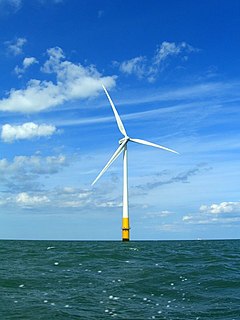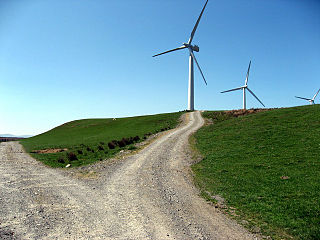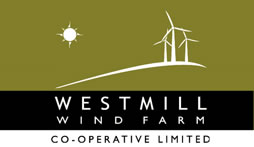
The ExPlace Wind Turbine is a 91-metre (299 ft) tall wind turbine located on the grounds of the Exhibition Place co-owned by the WindShare for-profit co-operative and Toronto Hydro. It is the first wind turbine installed in a major North American urban city centre, and the first community-owned wind power project in Ontario. WindShare itself was officially launched in February 2002 in Toronto, Ontario, Canada. It was created by the non-profit Toronto Renewable Energy Co-operative (TREC) which was incorporated in 1998. TREC continues to exist as a separate non-profit entity.

The United Kingdom is one of the best locations for wind power in the world and is considered to be the best in Europe. By the beginning of March 2022, the UK had 11,091 wind turbines with a total installed capacity of over 24.6 gigawatts (GW): 14.1 GW of onshore capacity and 10.4 GW of offshore capacity, the sixth largest capacity of any country in 2019. Wind power contributed 24.8% of UK electricity supplied in 2020, having surpassed coal in 2016 and nuclear in 2018. It is the largest source of renewable electricity in the UK. The UK Government has committed to a major expansion of offshore capacity by 2030.

Challicum Hills Wind Farm is a wind farm encompassed by 35 NEG NM 64 wind turbines, with a total generating capacity of 52.5 MW of electricity. The wind farm is near Ararat in western Victoria, Australia. The power station was commissioned in August 2003 and is in a long term Power Purchase Agreement (PPA) with Origin Energy.

Wind power is one of the main renewable energy sources in Australia and contributed 10% of electricity supplied in 2020, with 37.5% of total renewable energy supply. Australia has excellent conditions for harvesting wind power with abundant wind resources located close to population centres in the southern parts of the country and on the slopes of the Great Dividing Range in the east.

Blood Hill is a wind farm near Hemsby in Norfolk, England. It is the smallest windfarm owned by E.ON; taking up 3 hectares. It has a nameplate capacity of 2.25MW which is enough to power 1000 homes at peak. There were 10 Vestas V27-225 kW turbines which were 30 metres tall and stand on top of Blood Hill. They are visible from the villages of Hemsby and Winterton-on-Sea. Blood Hill began operating in December 1992 and was one of the first windfarms in the United Kingdom.

Wind power in Scotland is the fastest-growing renewable energy technology, with 9,347 MW of installed wind power capacity as of June 2020. This included 8,366 MW from onshore wind in Scotland and 981 MW of offshore wind generators.

Burton Wold Wind Farm is a wind farm located near Burton Latimer in the English county of Northamptonshire, UK. The Wind Farm was developed by Your Energy Ltd, is owned by Mistral Windfarms and operated by Engineering Renewables Ltd. E.ON UK is buying the electricity output of the project under a long-term power purchase agreement. The farm is spread over three hectares. It has an installed capacity of 20 MW and generate on average around 40,000,000 units of electricity annually.

Community wind projects are locally owned by farmers, investors, businesses, schools, utilities, or other public or private entities who utilize wind energy to support and reduce energy costs to the local community. The key feature is that local community members have a significant, direct financial stake in the project beyond land lease payments and tax revenue. Projects may be used for on-site power or to generate wholesale power for sale, usually on a commercial-scale greater than 100 kW.

The Kentish Flats Offshore Wind Farm is a wind farm located off the coast of Kent, England on a large, flat and shallow plateau just outside the main Thames shipping lanes. The wind farm is operated by Vattenfall.

The Hepburn Wind Project is a wind farm built and owned by Hepburn Wind, a community co-operative, and supported by the Victorian Government. The location of the project is Leonards Hill, 10 kilometres (6.2 mi) south of Daylesford, Victoria, north-west of Melbourne, Victoria. It comprises two individual 2.05 MW wind turbines supplied by REpower System AG which are projected to produce enough energy for 2,300 households, almost as many houses are in the twin-towns of Daylesford and Hepburn Springs.

Moel Maelogan(shown on O.S. maps as 'Maelogen', and also sometimes spelled 'Moelogan' and 'Mælogan') is a hill on the western edge of Mynydd Hiraethog in north Wales, and overlooking the Conwy Valley. It is known mostly as the general location of a wind farm.

Westmill Wind Farm Co-operative Ltd is a community-owned Industrial and Provident Society that owns 100% of the Westmill Wind Farm which is an onshore wind farm near the village of Watchfield in the Vale of White Horse, England. It has five 1.3 MW wind turbines erected in a line along the disused runway of the former RAF Watchfield. The wind farm has a power output of up to 6.5 MW, projected to produce as much electricity in a year as used by more than 2,500 homes. The turbines were erected in 8 days and the first fully month of generation was March 2008. It has an open day usually in June each year.

Torrs Hydro is a micro hydroelectric scheme, owned by the community, in New Mills, Derbyshire. It is located on the River Goyt, immediately after its confluence with the River Sett at the Torr weir. A 2.4-metre diameter steel trough screw turbine generates up to 63 kW of electricity.

Winscales Moor Wind Farm is a group of 7 turbines located between the A595 and A66, near Winscales, in Cumbria, England. The turbines have a tip height of 81 metres, the total installed capacity is 5.95 MW. The wind farm was developed by Your Energy Ltd and is owned by Mistral Windfarms. Engineering Renewables Ltd manage the construction and operation.

The Delabole wind farm was the first commercial onshore wind farm built in the United Kingdom, in November 1991. This field of wind turbines was initially developed by Windelectric Management Ltd.

Walney Wind Farms are a group of offshore wind farms 9 miles (14 km) west of Walney Island off the coast of Cumbria, in the Irish Sea, England. The group, operated by Ørsted, consists of Walney Phase 1, Phase 2 and the Walney Extension. The extension has a capacity of 659 MW making it the world's second largest offshore wind farm.
REG WindPower is a renewable energy company, in the United Kingdom.
Pen y Cymoedd is a wind farm located between Neath and Aberdare in south Wales. It opened in 2017.

















